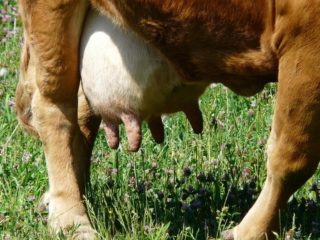Content
Cases where a cow has passed the calving period are common. Here we still need to find out what each of the owners means by the word “transferred”. On average, pregnancy lasts 285 days ± 2 weeks. This raises the question of when to consider the calving period to have passed.
Why does a cow go beyond calving time?
There are many reasons for delayed calving in cows. And not all of them are happy:
- twins;
- goby;
- large fruit;
- overstaying;
- false pregnancy;
- mummification of the fetus.
In most cases, owners believe that if a cow goes past her calving period, she will have twins. In fact, cattle belong to the group of single-bearing animals, just like horses. The birth of twins occurs only in 1-2% of cases. And usually this is a very undesirable phenomenon. If two eggs are fertilized at once, there is a high risk of miscarriage. And the born calves will be weaker than “single” calves. Just because a cow is past her due date does not mean there will definitely be twins. The number of late calvings far exceeds the number of twins in cattle.
This variation is explained by the fact that bulls “sit” in the womb for a long time. Males in almost all mammal species lag behind females in development. Even after birth.Therefore, with an early calving, you should rather wait for a heifer, and with a late calving, a bull. A cow can also cross if she calves a large calf. But here, perhaps, the issue is precisely the delay in calving. The fetus has time to grow. And in this case, cause and effect are confused. The cow did not cross because the fetus is large, but the calf grows large due to late calving. The delay in this case occurs due to a slight hormonal imbalance. The body does not have enough oxytocin to “start” the calving process. Such a failure does not particularly harm pregnancy, only prolonging it.
Sometimes a so-called “overrun” happens. This word has two meanings. One means serious problems with the health of the cow, the second only indicates that the animal was fertilized later. It's pregnant. But the calving date will have to be determined not by calculation, but by external signs. This can happen if there is a bull nearby. The first time, the cow was not fertilized and “secretly” went to the bull in the next heat from her owners. Things are worse with pathologies.

If the cow is overdue, calving may be unexpected for the animal owner
Pathological causes
False pregnancy is caused by too high hormonal levels. Outwardly, everything proceeds as if an embryo is developing in the womb. Often, even with a rectal examination, it is impossible to determine that the cow has been empty. Ultrasound can help here. The development of false pregnancy before calving can occur in 3 ways:
- the belly will “deflate” without consequences;
- there will be a “calving”;
- pyometra will develop.
During a false pregnancy, animals often “give birth” and assign anyone and anything, even inanimate objects, to the role of the baby.
Mummification of the fetus develops in the middle of pregnancy. The embryo dies, but since the cervix is closed, putrefactive bacteria cannot penetrate inside. Due to reduced contractility of the myometrium and a closed cervix, the fetus remains in the womb. Gradually it dries out and mummifies.
When mummified, animals show no signs of heat, and the owner believes that the cow is pregnant. The problem will “go away on its own” if the muscles of the uterus begin to contract. But it is in this case that the cow passes for more than 3 weeks. Mummified embryos always emerge very late. Often the fetus has to be removed artificially after injections of appropriate hormones. The latter are needed so that the cervix opens, and the veterinarian is able to get to the embryo.
How long can a cow carry a calf?
Usually a cow walks for about 10 days. Maximum 26 days. This just fits into the pregnancy duration of 260-311 days. Although, according to the experience of livestock breeders, extending the calving period by even 3 weeks is rare. Most often no more than 15.

The approximate place of application of force during the “push test”, if the uterus has passed its term, this can determine whether there is a living calf inside
What to do if a cow is overdue for calving
Until the deadline has expired, you don’t have to worry too much. But it is necessary to monitor the progress of pregnancy. Late calving is usually difficult due to the fact that the fetus has time to grow beyond normal.
If you have doubts at a later date, you can independently check whether the calf is there and whether it is alive. To do this, the cow is pushed firmly, but not sharply, in the stomach from the bottom right. The cub will immediately be indignant at this treatment and give a response push.
If the cow has been transitioning for 3 weeks, counting from the 285th day, it is better to invite a specialist who can determine the presence of pregnancy. Provided the "push test" fails. If the calf kicks and the udder begins to fill, all that remains is to wait for calving and remember that herbivores can arbitrarily shift the date by a day. This is a defense mechanism. They do not give birth if there is a disturbing factor. In this case, the owner himself may be the reason for such a daily delay.
Conclusion
If a cow is more than 3 weeks past calving, the owner has cause for concern. Shifting the settlement date by 10 days is a common occurrence, there is nothing to worry about. Animals are not machines to produce offspring strictly within specified periods.








